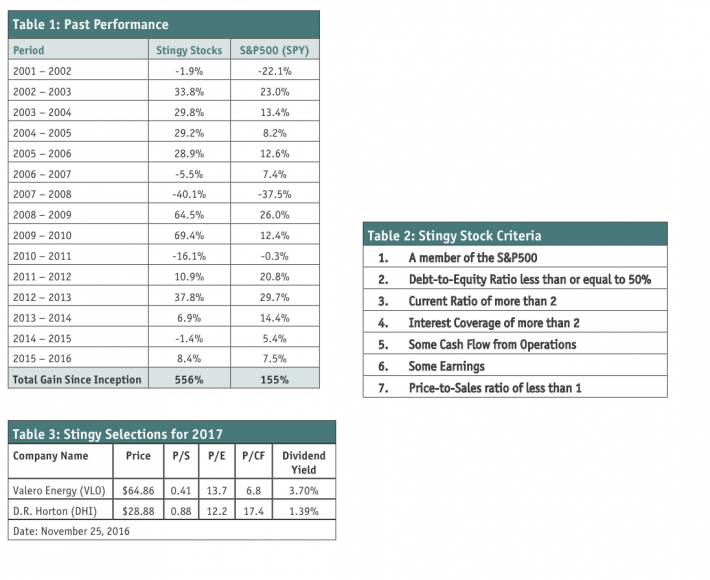Two Stingy Stocks For 2017
 The list of Stingy Stocks got its start in the Canadian MoneySaver way back in 2001. The idea was, and still is, to try to beat the S&P 500 by picking value stocks from within the index itself using a numbers-based approach.
The list of Stingy Stocks got its start in the Canadian MoneySaver way back in 2001. The idea was, and still is, to try to beat the S&P 500 by picking value stocks from within the index itself using a numbers-based approach.
I'm pleased to say that it has been a successful effort so far. The Stingy Stocks have gained an average of 13.5 per cent per year since 2001. By way of comparison, the S&P 500 (as represented by the SPY exchange traded fund) climbed 6.5 per cent per year over the same period. As a result, the Stingy Stocks have outperformed the index by an average of 7.0 percentage points annually. You can examine the full performance record in Table 1.
Due to a nice bump after the U.S. election, the Stingy Stocks managed a gain of 8.4 per cent since my last update for the Canadian MoneySaver. The S&P 500 (SPY) trailed with an advance of 7.5 per cent over the same period.
It is important to remember the method has had its ups and downs over the years. Investors who follow it should be prepared to take the good with the bad.
When hunting for Stingy Stocks I search for companies that are cheap compared to their fundamentals and relatively safe.
On the value front, I like stocks that trade at price-to-sales ratios of less than 1. Typically only a few pass the test and this year was no exception.
Cheap stocks are great but I also want some assurance they won’t go bust. That's why I start with firms in the S&P 500, which tend to be large and relatively stable compared to smaller firms.
Because size is an insufficient measure of safety, I also look for companies with little debt and lots of assets. Such firms are stronger than companies perched precariously on mountains of debt.
Three ratios are useful when looking for companies with little debt. Perhaps the most important is the debt-to-equity ratio which is calculated by dividing a company’s debt by its shareholders' equity. The amount of debt that a company can comfortably support varies from industry to industry but debt-to-equity ratios of more than 1 can be too high. I prefer very conservative companies with debt-to-equity ratios of 0.5 or less.
The next balance sheet figure to consider is the current ratio which is calculated by dividing a company’s current assets by its current liabilities. Current assets are assets, such as receivables and inventory, that can be turned into cash within the next year. Current liabilities are payments that a company must make over the next year. Naturally, an investor would like a company’s current assets to be much more than its current liabilities and I prefer conservative companies with current assets at least twice as large as current liabilities. After all, you can be pretty sure that a firm’s creditors will demand prompt payment of the current liabilities. On the other hand, some current assets, such as inventory, might not turn out to be worth as much as expected.
Finally, a company’s earnings before interest and taxes should be large in comparison to its interest payments. The ratio of earnings-before-interest-and-taxes to interest payments is called interest coverage and I like this ratio to be at least two or more.
While the debt ratios I’ve selected are useful in determining a firm’s ability to shoulder debt, they are not perfect. For instance, some long-term obligations may not be fully reflected on a company’s balance sheet and are, sensibly enough, called off-balance sheet debts. Regrettably, off-balance sheet debt can be a source of considerable consternation. Things like unexpected legal liabilities can sideswipe what might otherwise be a good investment. That’s why, as with all screening techniques, you should embark on a more detailed investigation of each stock before making a final investment decision.

Continuing the safety theme, I also want a company to show some earnings and cash flow from operations over the last year. After all, a business isn't likely to go bust when it is profitable and has cash coming in the door.
That’s a daunting list of requirements but I’ve summarized the primary factors in Table 2.
There are a grand total of two Stingy Stocks this year. They are Valero Energy (VLO), a refiner, and home builder D.R. Horton (DHI). You can examine each stock's dividend yield and multiple of sales (P/S), earnings (P/E), and cash flow (P/CF) in Table 3.
It is important to be aware that a well-diversified portfolio should hold more than 20 stocks. That's why, if you're keen on this year's Stingy Stocks, you’d be wise to use them to supplement an already reasonably diversified portfolio.
While I hope my method piques your interest, be sure to do your own due diligence before rushing to buy any stock. Check that its situation hasn't changed in some important way. Read the latest press releases and regulatory filings. Scan news stories for developments. If you take these steps, you'll be more comfortable with your investments and more likely to succeed over the long term.
Norman Rothery, PhD, CFA, Founder of StingyInvestor.com, Toronto, ON (416) 243-9580, rothery@stingyinvestor.com, www.stingyinvestor.com

